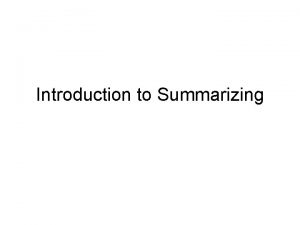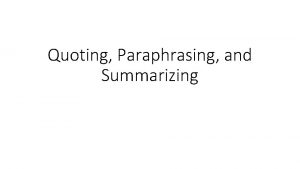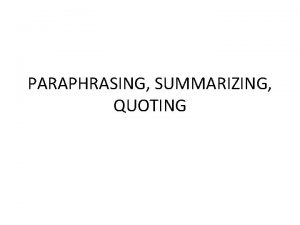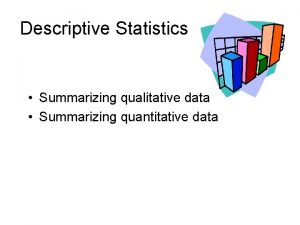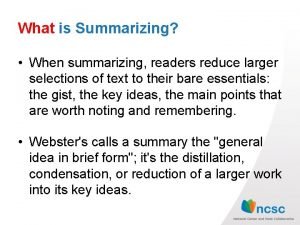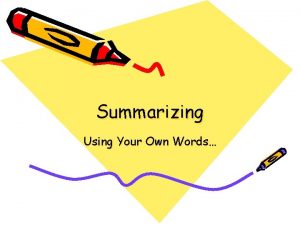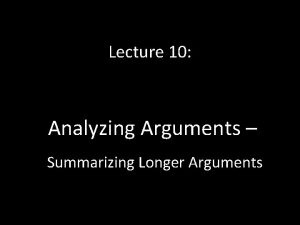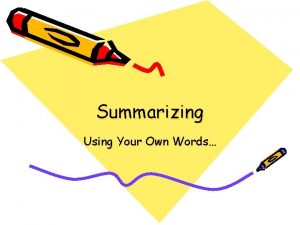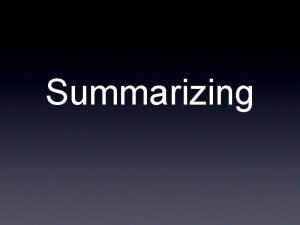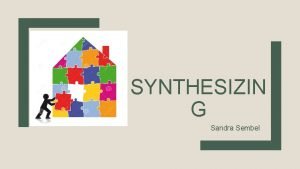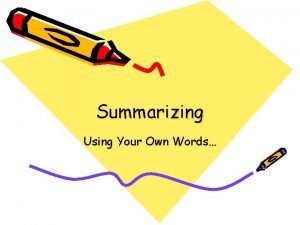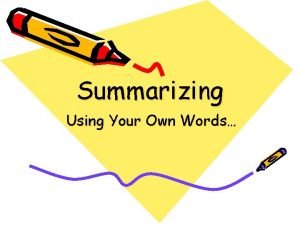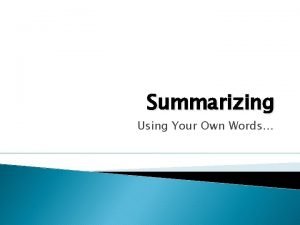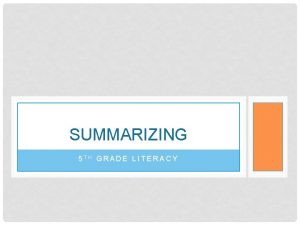Preparing for the Exam Summarizing the Essentials Exam






















- Slides: 22

Preparing for the Exam: Summarizing the Essentials

Exam • Final: 27. 10. 2008 at 8 - 10 ECO, lecture room • Retake: 24. 11. 2008 at 8 - 10 ECO, lecture room • Requirements: (a) Lectures, (b) Krugman (1993): What Do Undergrads Need to Know About Trade? American Economic Review 83(2): 23– 26 (available from JSTOR) • Three questions (answer all) • You may answer in English or Finnish. Dictionaries are not allowed. 2

Previous results (final exam) 3

The most important things to learn • Why trade is mutually beneficial? n Comparative advantage, economies of scale • Where do the world prices come from? n Terms-of-trade analysis • What does trade and international factor mobility do to distribution of income? n Factor-price-equalization theorem • What trade policy instruments do? n n Implications of subsidies, tariffs, quotas Arguments for activist trade policy Please note that these are just the most important things. To pass the exam you will need to know a bit more… 4

Gains from Trade: Ricardian Model Suppose that the international price turns out to be 2, 5 yard per barrel and England produces only cloth Cloth 9, 000 Slope of the CPF = the amount of consumption of one good that must be given up to obtain one additional unit of the other good England Cloth Wine 9, 000 0 4, 500 1, 800 0 3, 600 3, 000 3, 600 Wine 5

Gains from Trade: The Neoclassical/HO Model (PX/PY)FT Good Y Equilibrium: MRT = (PX/PY)FT = MRS Imports YC YA YP (PX/PY)A XC XA XP Exports Good X 6

Gains from Trade: Krugman Model • Trade increases market size → firms exploit more of the returns to scale → average cost decreases → price decreases → number of firms increases • i. e. a larger variety of products is available for smaller price • everybody are better off even if the countries are identical Price ACA ACFT p. A p. FT P n. A n. FT Number of firms 7

Good Y Prices: Deriving the Offer Curve YC Imports of good Y (PX/PY)1 Good Y Good X Exports 1 Imports 2 XP YC YP (PX/PY)2 XC XP Exports 2 Good X (PX/PY)2 = TOT 2 Potential price lines: PX*QX=PY*QY QY=(PX/PY)*QX i. e. given the prices, the value of exports equals the value of imports Imports 2 Imports 1 YP XC (PX/PY)1 = TOT 1 Exports of good X Exports 2 Exports 1 8

Prices: Putting the Offer Curves to One Graph Country 2 (PX/PY)1 Offer Curve Exports of good Y Imports of good Y Offer Curve Imports of good X Country 1 (PX/PY)2 Exports of good X Exports of good Y Imports of good X 9

Prices: Trading Equilibrium Good Y: Imports to country 1 exports from country 2 (PX/PY)E = TOTE (PX/PY)’ Country 2’s offer curve Country 1’s offer curve Good X: Exports from country 1 Imports to country 2 10

Distribution of Income: Factor Price Equalization • Autarky → Free trade o relative prices of final goods become identical n relative price of paper increases (=relative price of clothes decrease) in Finland → Finland produces more paper, China more clothes • Since producing paper is more capital intensive, demand for capital increases and demand for labour decreases in Finland → w↓r↑ • Similarly in China, demand for labour increases and demand for capital decreases → r ↓ w ↑ • In equilibrium all prices (including factor prices) are identical 11

Distribution of Income: the Stolper-Samuelson Theorem • Trade affects both the prices of goods and the prices of factors of production: What then is the impact of trade on distribution of real income? o wages decrease in Finland, but also the price of clothes decreases (i. e. you need less money to buy the same amount of clothes). Which effect dominates? • Stolper-Samuelson Theorem: real income of the owners of abundant factor increases and the real income of owners of scarce factor decreases o Think about the labour abundant country (e. g. China): Free trade → r ↓ w ↑ → capital/labour ratio ↑ → labour productivity ↑ → real wages ↑ 12 W. Stolper & P. Samuelson (1941): International Factor-Price Equalisation Once Again. Economic Journal 59, no. 234.

Distribution of Income: Impact of Migration Country 1’s eq’m employment Country 2: Country 2’s MPPL, w eq’m employment w. A 2 w* im m su igr rp ati lu on s Country 2: (receiving immigrants) • wages decrease → transfer of income from labour to capital owners • total output increases more than what is paid to the immigrants → immigration surplus • However, there is a decrease in per capita output (given diminishing marginal productivity) Country 1: • wages increase → transfer of income from capital to labour • total output decreases more than the wage sum of those who left → immigration deficit • But, there is a increase in per capita output (given diminishing marginal productivity) Country 1: MPPL, w transfer from capital to labour in country transfer from labour to capital in country 1 w* gain for the immigrants w. A 1 Country 1’s initial employment Country 2’s employment Total world labour force 13

Trade Policy: Import Tariff, Small-Country, Partial Equilibrium Increase of producer surplus and government income Loss of consumer surplus P SD P (1+τ)Pint increase of t gh producer i we s d surplus a s Loss of consumer surplus Pint de lo tariff to the government SD de ad w lo eig ss h t DD imports after tariff imports in free trade Q 14

Trade Policy: Import Quota Small-Country, Partial Equilibrium • For every quota there is an equivalent tariff (and for every tariff there is an equivalent quota) SD P • The changes in consumer and produce surplus are equivalent to that of a tariff • However, the increase of government revenue may be lost (at least partially) PQ Pint DD quota imports in free trade Q 15

Trade Policy: Subsidy, Small-Country, Partial Equilibrium SD P increase of cy n e producer i fic oss f e l surplus Cost to the government P P DD DD imports after the subsidy imports in free trade Q imports after the subsidy Q imports in free trade 16

Trade Policy: Single Market, Two Countries, Free Trade P Country A Country B P SA SB DB DA Q Q 17

Trade Policy: Single Market, Two Countries, Free Trade P Country A Country B P SA SB DB DA Q Q Countries A and B have different supply curves (cost of production) and demand curves 18 (preferences). In free trade equilibrium the world price is such that country B is willing to export the same quantity as country A is willing to import.

Trade Policy: Single Market, Two Countries, Tariff P Country A Country B P SA SB DB tariff DA Q Q Price in Country A = Price in country B + tariff. If the price in country B would remain constant 19 after a tariff is set, country B would be willing to export more that country A would be willing to import → price in country B must decrease (next slide)

Trade Policy: Single Market, Two Countries, Tariff Country A P DA Country B P SA DB SB PA PFT e a D b tariff C PB Q price decrease in country B Q Country A: Loss of consumer surplus = e+a+D+b; increase of producer surplus = e; Increase of government revenue = C+D. Gain for Country A = gains–losses = (e+C+D)-(e+a+D+b) = C – a – b. That is, if C > a + b country A has gained from the imposition of the tariff (due to lower prices of imports 20 before tariff).

General Equilibrium Effects of a Tariff for a Small Country • • Good Y CFT Ct Pt PX/(1+τ)PY PFT )t /P Y (P X • Import tariff on good Y changes the price ratio Producers adjust from point PFT to Pt Since the tariff doesn’t change world prices, country’s real income changes to (PX/PY)t Consumers maximize given domestic prices and real income and move to a lower utility level Note that real income is determined by the world prices (PX/PY)FT Ct Pt CFT PFT Good X 21

General Equilibrium Effects of a Subsidy for a Small Country • • • Assume the government subsidizes producer of good Y to impose the same production pattern as with the tariff The real income of the country remains the same Consumers face world prices and are able to consume at a higher utility level Good Y CFT CS PS PX/(1+τ)PY PFT (PX/PY)FT CS PS CFT PFT Good X 22
 Nyckelkompetenser för livslångt lärande
Nyckelkompetenser för livslångt lärande Atmosfr
Atmosfr Meios steg för steg
Meios steg för steg Lågenergihus nyproduktion
Lågenergihus nyproduktion Tidbok
Tidbok Myndigheten för delaktighet
Myndigheten för delaktighet Presentera för publik crossboss
Presentera för publik crossboss Rådet för byggkompetens
Rådet för byggkompetens Kontinuitetshantering i praktiken
Kontinuitetshantering i praktiken Kung dog 1611
Kung dog 1611 Tack för att ni har lyssnat
Tack för att ni har lyssnat Boverket ka
Boverket ka Referatmarkeringar
Referatmarkeringar Varför kallas perioden 1918-1939 för mellankrigstiden
Varför kallas perioden 1918-1939 för mellankrigstiden Karttecken brant
Karttecken brant Luftstrupen för medicinare
Luftstrupen för medicinare Enheter för massa
Enheter för massa Formel för lufttryck
Formel för lufttryck Elektronik för barn
Elektronik för barn Blomman för dagen drog
Blomman för dagen drog Borra hål för knoppar
Borra hål för knoppar Bris för vuxna
Bris för vuxna Mat för unga idrottare
Mat för unga idrottare























